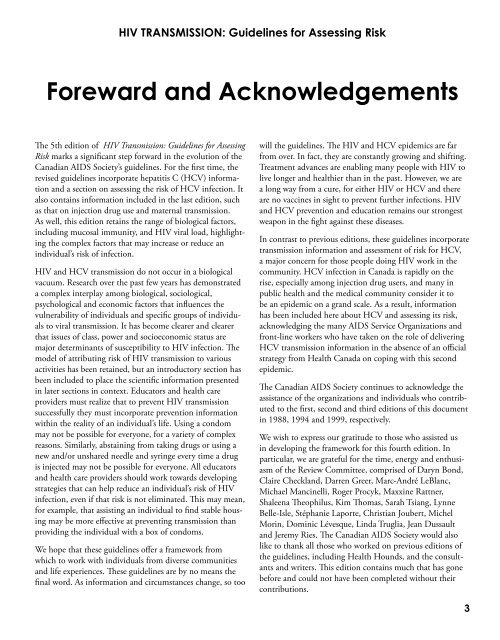HIV transmission: guidelines for assessing risk - Canadian AIDS ...
HIV transmission: guidelines for assessing risk - Canadian AIDS ...
HIV transmission: guidelines for assessing risk - Canadian AIDS ...
- No tags were found...
You also want an ePaper? Increase the reach of your titles
YUMPU automatically turns print PDFs into web optimized ePapers that Google loves.
<strong>HIV</strong> TRANSMISSION: Guidelines <strong>for</strong> Assessing RiskForeward and AcknowledgementsThe 5th edition of <strong>HIV</strong> Transmission: Guidelines <strong>for</strong> AssessingRisk marks a significant step <strong>for</strong>ward in the evolution of the<strong>Canadian</strong> <strong>AIDS</strong> Society’s <strong>guidelines</strong>. For the first time, therevised <strong>guidelines</strong> incorporate hepatitis C (HCV) in<strong>for</strong>mationand a section on <strong>assessing</strong> the <strong>risk</strong> of HCV infection. Italso contains in<strong>for</strong>mation included in the last edition, suchas that on injection drug use and maternal <strong>transmission</strong>.As well, this edition retains the range of biological factors,including mucosal immunity, and <strong>HIV</strong> viral load, highlightingthe complex factors that may increase or reduce anindividual’s <strong>risk</strong> of infection.<strong>HIV</strong> and HCV <strong>transmission</strong> do not occur in a biologicalvacuum. Research over the past few years has demonstrateda complex interplay among biological, sociological,psychological and economic factors that influences thevulnerability of individuals and specific groups of individualsto viral <strong>transmission</strong>. It has become clearer and clearerthat issues of class, power and socioeconomic status aremajor determinants of susceptibility to <strong>HIV</strong> infection. Themodel of attributing <strong>risk</strong> of <strong>HIV</strong> <strong>transmission</strong> to variousactivities has been retained, but an introductory section hasbeen included to place the scientific in<strong>for</strong>mation presentedin later sections in context. Educators and health careproviders must realize that to prevent <strong>HIV</strong> <strong>transmission</strong>successfully they must incorporate prevention in<strong>for</strong>mationwithin the reality of an individual’s life. Using a condommay not be possible <strong>for</strong> everyone, <strong>for</strong> a variety of complexreasons. Similarly, abstaining from taking drugs or using anew and/or unshared needle and syringe every time a drugis injected may not be possible <strong>for</strong> everyone. All educatorsand health care providers should work towards developingstrategies that can help reduce an individual’s <strong>risk</strong> of <strong>HIV</strong>infection, even if that <strong>risk</strong> is not eliminated. This may mean,<strong>for</strong> example, that assisting an individual to find stable housingmay be more effective at preventing <strong>transmission</strong> thanproviding the individual with a box of condoms.We hope that these <strong>guidelines</strong> offer a framework fromwhich to work with individuals from diverse communitiesand life experiences. These <strong>guidelines</strong> are by no means thefinal word. As in<strong>for</strong>mation and circumstances change, so toowill the <strong>guidelines</strong>. The <strong>HIV</strong> and HCV epidemics are farfrom over. In fact, they are constantly growing and shifting.Treatment advances are enabling many people with <strong>HIV</strong> tolive longer and healthier than in the past. However, we area long way from a cure, <strong>for</strong> either <strong>HIV</strong> or HCV and thereare no vaccines in sight to prevent further infections. <strong>HIV</strong>and HCV prevention and education remains our strongestweapon in the fight against these diseases.In contrast to previous editions, these <strong>guidelines</strong> incorporate<strong>transmission</strong> in<strong>for</strong>mation and assessment of <strong>risk</strong> <strong>for</strong> HCV,a major concern <strong>for</strong> those people doing <strong>HIV</strong> work in thecommunity. HCV infection in Canada is rapidly on therise, especially among injection drug users, and many inpublic health and the medical community consider it tobe an epidemic on a grand scale. As a result, in<strong>for</strong>mationhas been included here about HCV and <strong>assessing</strong> its <strong>risk</strong>,acknowledging the many <strong>AIDS</strong> Service Organizations andfront-line workers who have taken on the role of deliveringHCV <strong>transmission</strong> in<strong>for</strong>mation in the absence of an officialstrategy from Health Canada on coping with this secondepidemic.The <strong>Canadian</strong> <strong>AIDS</strong> Society continues to acknowledge theassistance of the organizations and individuals who contributedto the first, second and third editions of this documentin 1988, 1994 and 1999, respectively.We wish to express our gratitude to those who assisted usin developing the framework <strong>for</strong> this fourth edition. Inparticular, we are grateful <strong>for</strong> the time, energy and enthusiasmof the Review Committee, comprised of Daryn Bond,Claire Checkland, Darren Greer, Marc-André LeBlanc,Michael Mancinelli, Roger Procyk, Maxxine Rattner,Shaleena Theophilus, Kim Thomas, Sarah Tsiang, LynneBelle-Isle, Stéphanie Laporte, Christian Joubert, MichelMorin, Dominic Lévesque, Linda Truglia, Jean Dussaultand Jeremy Ries. The <strong>Canadian</strong> <strong>AIDS</strong> Society would alsolike to thank all those who worked on previous editions ofthe <strong>guidelines</strong>, including Health Hounds, and the consultantsand writers. This edition contains much that has gonebe<strong>for</strong>e and could not have been completed without theircontributions.3
















